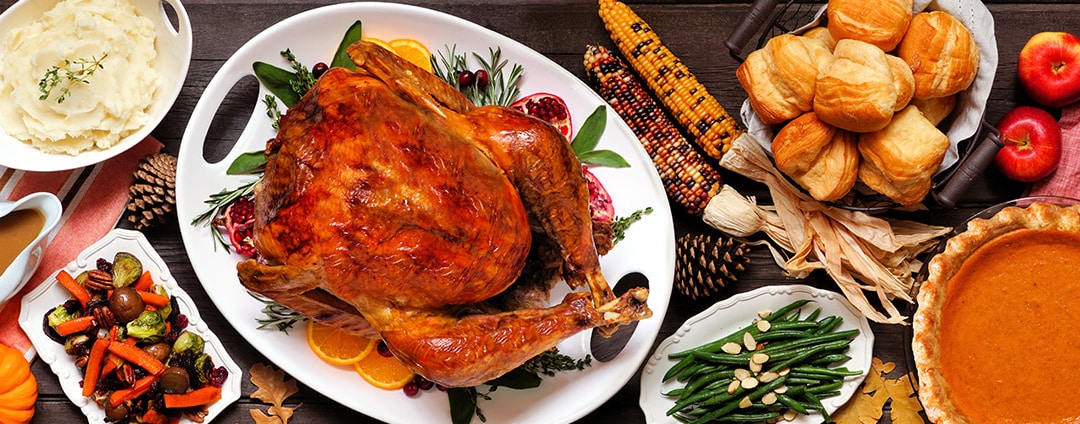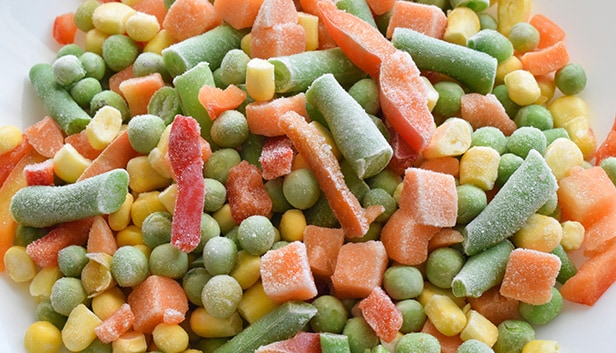Wells Fargo Thanksgiving Food Report

Turkey Triumph: The Bird that Beat Inflation
Wells Fargo Agri-Food Institute reveals how smart shopping and brand competition helped bring down the cost of a 10-person feast to $80 in 2025
Presented by Dr. Michael Swanson, Chief Agricultural Economist; Robin Wenzel, Head of Wells Fargo Agri-Food Institute; and Courtney Schmidt, Agri-Food Institute Sector Manager
In a win for consumers and a testament to the behind-the-scenes coordination between producers and retailers, the American consumer will have reason to celebrate this Thanksgiving. Even though the cost of food at home measured by the Consumer Price Index (CPI) is up 2.7% from a year ago, the cost of Wells Fargo’s Thanksgiving menu has fallen by about 2 to 3%, depending on the shopper’s strategy. It is fascinating to explore this difference and why it is happening. At the heart of the uptick in the CPI’s food-at-home increase is protein, specifically beef and eggs, which are not on the Thanksgiving menu. Without those items, consumers will find relief in a traditional Thanksgiving meal. An all private-label (store brand) menu comes in at $80, while an all national-name brand menu totals $95.* Budget conscious consumers will also have room to mix and match based on preference.
Turkey triumph: The bird that beat inflation
Let’s start with the All Star of Thanksgiving, the turkey. National name brands show year-over-year savings, as America’s turkey producers and retailers coordinate all year to bring many birds to the supermarket for the rush of buying. Estimated retail prices are down 3.7% from a year ago for national brands. According to Circana, the turkey market sells the majority of the whole birds in the two weeks just before Thanksgiving, however, the rest of the year they are producing turkeys for sandwich meat and other delicious products. The turkey industry takes orders from the supermarkets months in advance for Thanksgiving. It looks like producers picked the right number of birds to prepare, and the price reflects the lower cost of feeding turkeys in a competitive market. While turkey is the clear winner for the centerpiece of the table, if guests are not fans of the bird, roast chicken and spiral cut ham are other moderately priced proteins to consider when feeding a crowd.
Frozen veggie showdown: National brands vs. private label
Here’s where the private-label and national brand showdown gets interesting. National name brand frozen vegetables are down a whopping 15%. In contrast, private label frozen vegetables barely changed, increasing 0.8%. Clearly the consumer has pressured the national brands to offer more value to get their share of the sales. Those who prefer cooking fresh veggies, can expect prices to be similar or slightly higher than frozen. However, shoppers are encouraged to shop around for deals, especially with big box retailers offering deals when buying in bulk.
Cranberries, gravy, rolls and pumpkin pie: The unsung heroes of holiday savings
Private brand dinner rolls saw the biggest savings this year with a 22% price decrease. This reflects a softness in consumer demand for traditional bread products. The next group of savings comes from stuffing for the turkey, prepared gravy mix, and fresh cranberries. All of these key sides dropped between 3 and 4 % from last year. Like frozen vegetables, they are being pressured by more supply and private label price competition. The sweetest savings are seen with national brand pumpkin pies, down 3%. To save on these items, shoppers should select private label for stuffing, dinner rolls and gravy mix, but when it comes to fresh cranberries and pumpkin pie, consumers can head straight to the national brands.

Mix and match: Shoppers should select private label for stuffing, dinner rolls and gravy mix, but when it comes to fresh cranberries and pumpkin pie, consumers can head straight to the national brands.

Frozen veggie strategy: National brands are offering deep discounts; don’t assume private label is always cheaper.
Mashed potato magic: Convenience meets cost savings
Prepared mashed potatoes are a new addition to the Wells Fargo Thanksgiving Day menu. This category has seen explosive growth over the last several years thanks to its quality and convenience. No doubt, you can save money by buying a ten-pound bag of spuds and getting to work with a peeler, boiling and mashing. However, many Americans find the trade-off of money for convenience a great deal in this case. This category saw a price drop of 1.5% from last year with a better potato crop and competition at work. And, with private and national brands in a price tug of war, consumers can make their final selection based on preference not cost.
Sides holding the line: Stability in a volatile market
There were two categories that stayed the same or increased slightly from last year. Prepackaged salad mix nudged higher by 0.3% and whipping cream rose 3%, which is in line with the dairy category as a whole (up 1.4% year-over-year). Last year’s price savings in dairy have been reversed slightly, leaving the category more or less flat. Like potatoes, the price of these items are within reach of one another in the national and private label challenge, so again, the consumer has the freedom to choose based on preference.
Beer’s bubbling, wine’s wobbling, and soda’s split: Thanksgiving drinks are making moves
It would not be a celebration without the beverages. This Thanksgiving has the same up and some down activity in the beverage category. The beer sector is up 3% from a year ago even as the category has faced some slowdowns in consumption over time. In contrast, the wine category as a whole is flat at very slight decline of 0.1% from last year. Soft drinks have seen an interesting split with 12 ounce can pricing falling 3% from last year, but the big 2-liter bottle pricing is up 7% over the same period. Even with that difference in price change, the big bottles offer big price savings. The BLS reports that the average 12 ounce can of soda is less than $1, but you can get two liters for $2.21. That makes the big bottles 31% less expensive than the cans, so break out some cups and ice cubes.
Turkey day feastonimics: Cook up a side of strategy for the big day
This Thanksgiving, consumers have more control over their grocery budgets than they might expect. Thanks to strategic coordination between producers and retailers, and the growing strength of private label offerings, a full holiday meal for ten can be served for just $80. While inflation continues to impact certain categories like beef and dairy, shoppers who stick to a traditional Thanksgiving menu and shop wisely between national and store brands can unlock meaningful savings. With thoughtful choices and a bit of planning, the CFOs of the Thanksgiving table can deliver a festive, satisfying meal without breaking the bank.

Dr. Michael Swanson, Chief Agricultural Economist
Michael Swanson, Ph.D. is the Chief Agricultural Economist within Wells Fargo's Agri-Food Institute. He is responsible for analyzing the impact of energy on agriculture and strategic analysis for key agricultural commodities and livestock sectors. His focus includes the systems analysis of consumer food demand and its linkage to agribusiness. Additionally, he helps develop credit and risk strategies for Wells Fargo’s customers, and performs macroeconomic and international analysis on agricultural production and agribusiness.
Michael joined Wells Fargo in 2000 as a senior economist. Prior, he worked for Land O’ Lakes and supervised a portion of the supply chain for dairy products, including scheduling the production, warehousing, and distribution of more than 400 million pounds of cheese annually, and also supervised sales forecasting. Before Land O’Lakes, Michael worked for Cargill’s Colombian subsidiary, Cargill Cafetera de Manizales S.A., with responsibility for grain imports and value-added sales to feed producers and flour millers. Michael started his career as a transportation analyst with Burlington Northern Railway.
Michael received undergraduate degrees in economics and business administration from the University of St. Thomas, and both his master’s and doctorate degrees in agricultural and applied economics from the University of Minnesota.

Courtney Buerger Schmidt, Sector Manager
Courtney Buerger Schmidt is a Sector Manager within Wells Fargo’s Agri-Food Institute focused on the protein, cotton, and hay sectors. Courtney originally joined Wells Fargo in 2014 as a relationship manager within The Private Bank Wealth Management group where she spent two years prior to assuming her current role. Before Wells Fargo, Courtney spent six years as a commodity broker and research analyst with Frontier Risk Management developing hedge and risk management strategies for Agribusiness clients, and also served as assistant director of the research division that focused on livestock, grain, and oilseed.
Courtney holds a Bachelor of Science degree in Agricultural Economics with an emphasis in finance and real estate from Texas A&M University. Courtney was recently selected for Texas Agriculture Lifetime Leadership (TALL) Cohort XVIII 2022-2024. She is also a member of the Texas A&M College of Agriculture Development Council.

Robin Wenzel, Head of Wells Fargo Agri-Food Institute
Robin Wenzel is a senior vice president and the Head of Wells Fargo’s Agri-Food Institute, a team of national industry advisors providing economic insights, analytics, research, and reporting across the agribusiness, food, and beverage spectrum. With more than 30 years of commercial and corporate banking experience, Robin leads with a strategic vision and an ability to expand and execute on the team’s deliverables to better support Food, Beverage, and Ag customers and prospects.
Robin received her degree in Business from the University of San Francisco with an interest in Finance and International studies.
Robin has long been recognized for her work as a leading voice in the wine industry in Napa, CA. She is also a recipient of the 2017 North Bay Business Journal Women in Business Award.
Data reported by Nielsen (“NIQ”) for the latest 52 weeks ending 9/06/2025, for the United States.
Circana, fresh turkey, whole birds, 16-14 lbs., Total US - Multi Outlet+, 2024 data
All beverage price data is from the Consumer Price Index published by the Bureau of Labor Statistics through August 2025
* Wells Fargo’s 10-person menu includes: turkey, stuffing, frozen vegetables, prepared mashed potatoes, gravy, fresh cranberries, dinner rolls, salad mix, pumpkin pie and whipped cream for the pie.
RO-4902865
LRC-1025

